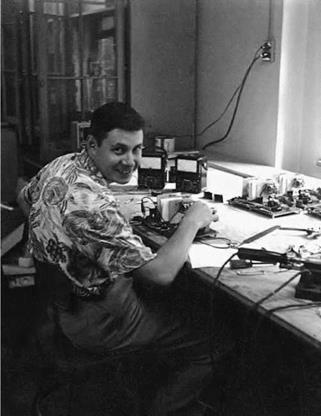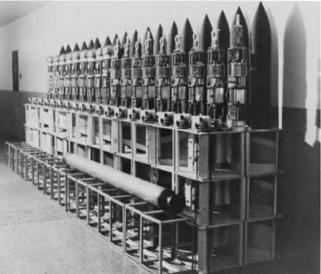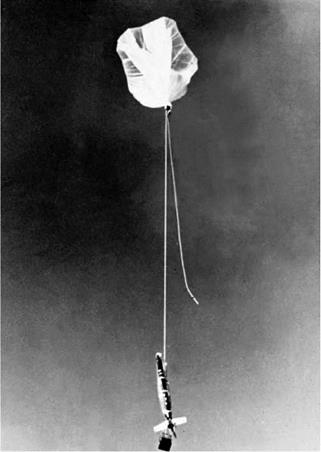The summer 1953 rockoon expedition
After the initial development and field proof of the rockoon technique in 1952, Van Allen, his students, and Gottlieb were eager to put this new tool to further use. Expeditions were mounted in the summers of 1953, 1954, 1955, and 1957 to exploit that new capability. The focused goal of the one in 1953 was to extend the 1952 observations to a larger latitude range and to obtain more information about the nature of the particles.
Les Meredith prepared a set of rockoons that were generally similar to those he flew in 1952, including the use of the same Deacon jet-assisted-takeoff-based rockets. Larger Skyhook balloons (up to 100 feet in diameter) were selected to increase the altitude of the rocket firing to as high as 70,000 feet (over 13 miles), thus permitting peak rocket altitudes of well over 300,000 feet (57 miles). A cutoff device was added near the balloon’s neck to drop the rockets for safety reasons if, after a few hours’ flight, the balloons descended below 30,000 feet or the rockets did not fire. His total payload weights were 30 pounds, 2 pounds heavier than the 1952 payloads.
Student Robert (Bob) A. Ellis Jr. had helped with the rockoon work from the beginning but elected in 1952 not to commit to them for his thesis work. When it was time to prepare for the 1953 expedition, however, Bob had become a convert and wholeheartedly joined that endeavor. He prepared rockoon instrumentation to measure total cosmic ray ionization.
 OPENING SPACE RESEARCH
OPENING SPACE RESEARCH
|
His instrument was generally similar to his 1952 instrument, as shown earlier in Figure 1.3 (b). The complete array of instruments is shown as they were prepared for shipment in Figure 2.2.
For that second rockoon-launching expedition, I received my introduction to the art of rocket instrumentation by helping both Les Meredith and Bob Ellis assemble their packages. The extended field operation, sponsored by the Office of Naval Research (ONR) and Atomic Energy Commission as Project Muskrat, took place during July, August, and early September 1953 aboard the U. S. Navy icebreaker USS Staten Island.2 The State University of Iowa (SUI) expedition members were Mel Gottlieb as team leader and students Meredith and Ellis. They were assisted by the always – capable and valuable support of the ONR’s Lieutenant Malcolm Jones.
Boarding the icebreaker USS Staten Island at Boston, the Iowa threesome set up a trailer laboratory on the helicopter flight deck. A Naval Research Laboratory (NRL) group led by Herman E. LaGow also boarded with their rockoons and receiving
|
CHAPTER 2 • THE EARLY YEARS
FIGURE 2.2 Equipment for the 1953 rockoon expedition, ready for shipment. The instrumented nose cones are stacked on top of wooden frames containing the 18 tail fins. Meredith’s nine instruments are in the near-field, with the nose cones beside them, while Ellis’ nine instruments are to the rear. The electronic firing assemblies (on which I had been working in Figure 2.1) lie at the bases of the instruments. One empty Deacon rocket casing lies atop the firing gondola frames. (Courtesy of the Department of Physics and Astronomy Van Allen Collection, The University of Iowa, Iowa City, Iowa.) |
station to measure upper-atmosphere pressure, temperature, and density. His flights marked the beginning of rockoon flights by that organization.
The SUI contingent established a milestone in racial desegregation on that sailing. It was customary for the Navy to accord civilian researchers officer rank when on board their ships. When the Iowa group arrived in Boston, the ship’s crew discovered that Bob was black. The only blacks on board the ship in the past had been as members of the nonofficer crews—blacks had never been admitted to “officer country.” After due deliberation, the captain went ahead and housed Bob in the officer’s quarters and admitted him to the other officer’s facilities. Bob became an instant hero of the black crew members.3
The ship sailed from Boston harbor on Saturday, 18 July, and progressed toward Newfoundland and the Labrador Sea. After an initial failed launch attempt late on the first day, they tried igniting a firing charge suspended under a captive balloon off the ship’s fantail and concluded (probably erroneously) that they had installed the igniter backward for the first launch attempt. While three more unsuccessful rockoon flight attempts were made during the following day, the team worked feverishly to determine the cause of the problem. That first try at 6:30 AM, after meticulous verification that the igniter was properly installed, failed. The next try was with a bag of smokeless powder next to the igniter. That also failed. They thought their problem might be that


OPENING SPACE RESEARCH
a Bakelite plug in the rocket motor might have blown out when the rocket reached altitude. A third try to test that theory at about 6:00 PM also failed. That evening, they wired Van Allen to see if he could throw any light on their difficulties.
The ship traveled in poor visibility past the coast of Newfoundland during most of Monday. That morning, the researchers devised a rig with a cluster of small weather balloons to make a flight test of the firing box and igniter. Instead of the precious rockoon instruments, that flight used a radiosonde transmitter and receiver of the type used widely for meteorological sounding. Late that afternoon, they launched that flight but were further frustrated when the radiosonde’s shipboard receiving station failed.
Meredith worked all that night to build another variation on the small-balloon test system. For that test, another firing box was coupled to one of the rockoon flight transmitters, and the rockoon receiving station was set up to receive its signal. By Tuesday afternoon, although the ship was rolling about 10 degrees and the wind speed was near the maximum speed of the ship, they were able to attempt a launch of this new setup. Because of conditions, it was difficult to measure the balloon lift, and some of the balloons received small holes because of the difficult balloon-handling operations. The assembly rose only a few thousand feet before it drifted out of range.
At that point, the team decided that a vacuum chamber test might be informative, since the igniters had been designed originally for use at ground level. Finally, they hit pay dirt—that test on Tuesday evening with a vacuum chamber that Herman LaGow had brought along showed that the firing squib was blowing the igniter’s main
|
CHAPTER 2 • THE EARLY YEARS
FIGURE 2.4 A rockoon on its way aloft, shortly after release from the deck of the icebreaker USS Staten Island during the 1953 expedition. The balloon envelope is only partly full here, but its helium expanded to completely fill it as it climbed into the rarified air at rocket-firing altitude. The firing gondola can be seen directly below the rocket’s tail fins. (Courtesy of Leslie H. Meredith.) |
powder charge apart without burning it in the rarified air where the rockets were being expected to fire. They thought at first that they would pressurize the rocket, but that proved too difficult to do reliably in the field. Finally, on Wednesday, Lieutenant Jones devised a new arrangement, with a wire screen to reinforce the igniter’s plastic case and with black powder strung on the igniter’s hot wire. The black powder burned when the wire was heated by a firing current, and that ignited the main igniter charge. That field invention (referred to afterward as the Jones Igniter) worked well throughout the rest of the expedition.
Les Meredith’s informal expedition notes make very interesting reading, both in describing an Arctic field expedition and in conveying a highly personalized impression
28 OPENING SPACE RESEARCH
of the problems, excitement, and sense of adventure. His entry on their first day out, Saturday, 18 July 1953, elaborates on some of the initial operational and programmatic difficulties, starting with their departure from Boston:
Last night about midnight, the ship got some messages that it was to proceed to Saglek, Canada, “without delay.” We were supposed to leave this morning on our project. The sailing time was set at 9:00 A. M. In the literal meaning, the ship was to proceed to Saglek and shoot our rockets later. Gottlieb was all for getting off the ship and coming home. Since the ship was leaving at 9:00, however, there was not time to get everything packed so we stayed. It turned out the captain is a reasonable type of person and he was willing to delay the ship an hour or so to get a rocket off, but he could not sit and wait if there was a wind, or it was night, etc.
Today the wind has been only about five mph and it’s been a beautiful cloudless day. As a result, we were able to get one of Ellis’ [instruments] off about 5:30 PM. We had to wait that long so we would be far enough out. We left Boston about 9:15 AM and steered right along at about 14 knots all day. Ellis’ didn’t fire. We were able to watch the balloon with naked eye for over two hours. Then it got dark. It was just a small white spot and hard to find and keep track of. This evening we put the firing charge on a captive balloon off the back of the ship and blew it up with our firing mechanism. We figured out we had put it in the rocket backward.4
The ship arrived at Saglek Bay on the northern Labrador coast (about 58.5 degrees north geographic latitude) during the early morning of Thursday, 23 July. By that time, they had discovered the reason for their earlier problems and had high expectations that the next launch would be successful. But, since they were close to shore, rock – oon launches were not advisable. Les’ entry for that day described a day of forced relaxation for the researchers:
This has really been a day and a half. This morning we got up to find ourselves anchored at the end of Saglek Bay. The weather was beautiful. With a sweater, it was about right in the shade and a little warm in the sun. There were a few clouds and a slight breeze. The only drawback was the great number of large mosquitoes and flies. The morning was largely spent waiting for the afternoon.
In the afternoon, we took a landing boat to the beach. There was an abandoned army base there. All that was left was a barn and lots of empty oil drums. We hiked inland and climbed a mountain which was at least 2000 feet high. With my sweater on, I worked up a good sweat. Then we came down and walked along and fished in a clear mountain stream. In one pool, there were three or four large rainbow trout. They wouldn’t bite so we first threw rocks at them and ended up swimming in the pool. It was three or four feet deep and fifteen by twenty feet across. The bottom consisted of a large slab of rock, no sand or mut [mud?]. There were rapids at both ends. Then we came back to the ship. There was grass in places, a few low shrubs, and many different types of flowers including dandelions. Mostly there was what looked like a type of moss almost, and, of course, lots of rocks. This was especially true up on the mountain. The view from the mountain was really something. There were mountains all around and down below were the green valleys, lakes, and the ships in the harbor. There were four other ships here. The only life we saw were the fish, and some small gray birds (flies and mosquitoes). There were lots of holes in the ground, but we didn’t see what lived in them. Sunset was at 8:00 PM, EST tonight.5
CHAPTER 2 • THE EARLY YEARS
They were able to make the next launch attempt, using the field-rigged Jones Igniter, on Friday, 24 July, soon after the ship left Saglek Bay on its way toward Resolution Island. That also failed, but for a different reason—the weather worsened as they left the shelter of the bay, so there was a residual wind across the deck when the rockoon was released. The firing box was knocked off the load line during its initial ascent when it snagged on a flight deck net.
That incident highlighted an important aspect of balloon launches. As discussed earlier in connection with ground-based launchings, if a balloon is inflated when the wind speed relative to the launch site is more than a few miles per hour, the anchored balloon is blown aside above the payload. If the balloon is released under those conditions, gravity causes the payload to swing under the balloon like a pendulum, and it crashes into the ground, ship, or sea, nearly always damaging the instrument.
A ship can follow the wind to mitigate this effect. The standard operating procedure was to tie a small weather balloon to the ship’s railing so that it floated 100 feet or so above the deck in full view of the conning officer. The conning officer’s task was to steer the ship and adjust its speed to keep it centered under the balloon. With that accomplished, the relative wind speed across the deck was minimized, and inflation and launch could be accomplished with safety.
Of the five unsuccessful initial launching attempts, the first and third expended two of Ellis’ valuable instruments, and others wasted three of Meredith’s payloads.
On Saturday, 25 July, the ship reached Resolution Island, located at about 61.5 degrees north geographic latitude, across the mouth of Hudson Strait from northern Labrador. For the next considerable period, the ship worked in the Resolution Island area. Meredith’s entry for Sunday, 26 July 1953, indicates the general nature of the ship’s primary mission:
Nothing happened again today. We sat around off Resolution Island. It was overcast all day and sprinkled off and on. The main features were the large swells, which kept the boat rocking all day.
During most of the day, we had a line from the back of our ship to the front of a larger ship, a LSD (floating dry dock). Our job was to keep the nose of this ship pointed into the swells while it put small landing boats into the water, through a door at its back. Those boats were to take supplies into a radar station on the island, as the larger boats were afraid to go in because of the ice. Whether the small boats made it, I don’t know.
There didn’t appear to be too much ice. Quite a few small pieces, but nothing big.
Rolls of 10° were common. Some were as high as 20°. One was 30°. On this one, I went right out of my chair.6
On Tuesday, 28 July, 10 days after leaving Boston, the ship was again in sufficiently open water, and the Iowa team was finally able to launch its first successful flight. Meredith’s daily entry for that triumphal day reads:
This morning we got up at 4:30 A. M. for a flight. The wind was about ten miles per hour when we started and there was a heavy overcast. It sprinkled off and on, mostly on. At about
OPENING SPACE RESEARCH
![]() 6:30 A. M. we got the flight off. It was one of mine and had a hot wire igniter. It fired at 8:00 A. M. right on schedule. The reliability of the results is questionable. The terrible radio propagation and large aurora last night, which I didn’t see, may be related to results obtained. We’ll have to make another flight to check. When we launched, the wind was about twenty miles per hour, the maximum speed of the ship. This coupled with the fact that the General Mills load line was just barely long enough, three feet left on, which made the launching touch and go. Anyway, it went.7
6:30 A. M. we got the flight off. It was one of mine and had a hot wire igniter. It fired at 8:00 A. M. right on schedule. The reliability of the results is questionable. The terrible radio propagation and large aurora last night, which I didn’t see, may be related to results obtained. We’ll have to make another flight to check. When we launched, the wind was about twenty miles per hour, the maximum speed of the ship. This coupled with the fact that the General Mills load line was just barely long enough, three feet left on, which made the launching touch and go. Anyway, it went.7
Auroras occur in the upper atmosphere (predominantly above 60 miles altitude) at high northern and southern latitudes (centered at about 67 degrees north and south geomagnetic latitude). They are caused by energetic particles that are guided into the upper atmosphere by the Earth’s magnetic field. Some of those particles, those usually associated with the visibly diffuse aurora, are electrons and protons precipitating from the magnetospherically trapped particle populations (the later-discovered outer Van Allen Radiation Belt). Other particles, often associated with the more variable discrete aurora, are predominantly electrons arriving from outside the magnetosphere, primarily from the Sun.8 9
During the following days, the ship continued to work in the Resolution Island area in persistently marginal weather. But that Saturday evening, the scientists were able to talk the captain into sailing into open water to attempt another rockoon launch. During that attempt (with an NRL payload), a frightening incident occurred that could have been a major disaster. A wind gust came up after the balloon had been inflated. The balloon acted like a huge sail, and the resulting force broke the 1000 pound test line anchoring the balloon to the deck. The load line had not yet been attached to the rocket, but was lying coiled on the deck. Mel Gottlieb happened to be standing on that line when the balloon surged upward. Fortunately, he jumped free, and the line did not become entangled in his legs. If it had, the balloon would easily have borne him aloft, and they would have had no way to cut him down. That forcefully reminded everyone that shipboard rockoon launching is, fundamentally, a dangerous operation, and that strict adherence to rigorous safety practices is essential.
The ship remained in the Resolution Island and nearby Frobisher Bay areas for nearly two weeks, working on its primary mission to escort Navy ships through the ice. Departing there on late Wednesday, 5 August, it proceeded up the Davis Strait, across the lower end of Baffin Bay, and through Lancaster Sound to Resolute Bay (not to be confused with Resolution Island). Resolute Bay is located on Cornwallis Island, lying just northwest of Baffin Island and west of larger Devon Island. (See Figure 2.14 for the relative locations of those sites.)
More rockoon flights were made during that leg of the trip. By the time the ship reached Resolute Bay early on 10 August, a cumulative total of 10 SUI and three NRL rockoons had been launched. The icebreaker remained at Resolute Bay for some
CHAPTER 2 • THE EARLY YEARS 31
time, resuming its primary mission to support a number of ships in the icy water. Les Meredith left at Resolute Bay on 12 August via a Royal Air Force Lancaster mail plane so that he could begin his classes with the start of the new academic year. He returned to Iowa City via a circuitous path through Alert Base on the far northwestern shore of Ellesmere Island; Thule, Greenland; and Boston. The ship eventually proceeded to Thule, and then returned the rest of the expedition party to Boston on about September 5, with the expedition teams firing six additional SUI and two more NRL rockoons along the return path.
In all, 16 launch attempts were made by the Iowa group, and 6 were made by the NRL scientists. Seven of the Iowa instruments and three of the NRL instruments reached useful altitudes and produced usable data. Three of the successful Iowa flights carried Meredith’s single GM counters, and the other four carried Ellis’ ionization chambers.
Data from one of Meredith’s 1953 flights confirmed and extended his 1952 results. Those combined results served as the basis for his Ph. D. dissertation, as mentioned at the end of the previous chapter. Ellis’ flights, made at about 76 degrees, 86 degrees, and 56 degrees north geomagnetic latitude, served as the basis for his Ph. D. dissertation, where he reported that higher-charged primary cosmic ray nuclei (charge greater than or equal to six) were absent or nearly absent at magnetic rigidities below 1.5 x 109 volts.10
As mentioned briefly in the prologue, flights measuring cosmic ray intensity typically show an initial rise in the counting rate as the altitude increases. The rate reaches a peak value when the instrument passes through the so-called Pfotzer-Regener maximum (often shortened to Pfotzer maximum). That occurs where the counter detects the combined effect of incoming primary cosmic rays that have not yet interacted with the atmosphere, plus secondary particles that result from collisions of primary particles with atoms and molecules in the atmosphere. As the instrument proceeds even higher, the counting rate drops slightly and eventually flattens to an essentially constant value. At that point, the counter is too high to see many of the secondary particles, so that it registers almost exclusively the incoming primary cosmic rays. During rocket descent, the instrument passes again through the Pfotzer-Regener maximum, and the counter rate then drops to its sea-level value, where a preponderance of the primary and secondary cosmic rays have been absorbed by the atmosphere. Figure 2.5 beautifully illustrates this typical pattern.
The constant, or “plateau,” value above the Pfotzer-Regener maximum was the primary information for which the 1952 and 1953 expeditions were mounted. The goal was to determine those plateau values for various geomagnetic latitudes, in order that the effect of the Earth’s magnetic field could be used to help determine the energy spectrum of the primary cosmic rays.
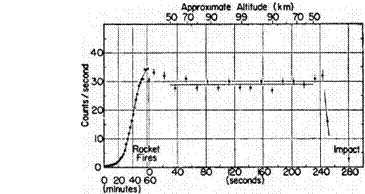 |
 |
OPENING SPACE RESEARCH
Although Meredith was dubious at the time about the quality of the data from the launch on 28 July 1953 (SUI flight 13), it turned out to be valid and resulted in an important new discovery. Launched just northeast of the mouth of Hudson Strait at about 74 degrees north geomagnetic latitude, it was the first flight to detect an anomalous radiation superimposed upon the normally expected cosmic rays, as shown in Figure 2.6. Flight of another of his instruments on 30 August (SUI flight 20) at about 64 degrees north geomagnetic latitude during the ship’s return showed a similar effect.
The data from flight 13 showed the expected counting rate during the early and late phases of the flight, where the instrument passed over the Pfotzer-Regener maximum soon after the rocket fired and again shortly before impact. But at higher altitudes, where the rate was expected to remain essentially constant, it climbed to a much higher value. The peak rate during that flight reached about four times the anticipated plateau value.
 |
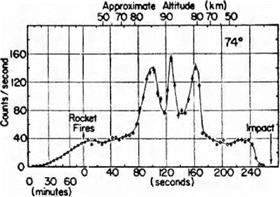 |
Because this anomalous effect was seen only during the two flights made in the neighborhood of the auroral zone, it was surmised that the observed extra radiation was linked to the production of the visible aurora. Those two flights were the basis
CHAPTER 2 • THE EARLY YEARS 33
for the original announcement in early 1955 of what was quickly termed the auroral soft radiation.11
It was tentatively hypothesized that the counters were seeing the high-energy tail of the particles producing the aurora, and that they probably were predominantly electrons having kinetic energies in the neighborhood of 1 MeV That early interpretation was modified after follow-on investigations in 1954 and 1955, as related later.











